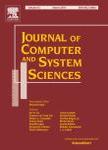版权所有:内蒙古大学图书馆 技术提供:维普资讯• 智图
内蒙古自治区呼和浩特市赛罕区大学西街235号 邮编: 010021

作者机构:IBM Almaden San Jose CA 95120 USA MIT Cambridge MA 02139 USA
出 版 物:《JOURNAL OF COMPUTER AND SYSTEM SCIENCES》 (计算机与系统科学杂志)
年 卷 期:2004年第68卷第2期
页 面:442-470页
核心收录:
学科分类:08[工学] 0812[工学-计算机科学与技术(可授工学、理学学位)]
基 金:IBM University National Science Foundation, NSF, (0098018-CCR, 9623859-CCR) Directorate for Computer and Information Science and Engineering, CISE, (0098018, 9623859)
主 题:approximation algorithms semidefinite programming maximum cut
摘 要:A number of recent papers on approximation algorithms have used the square roots of unity, -1 and 1, to represent binary decision variables for problems in combinatorial optimization, and have relaxed these to unit vectors in real space using semidefinite programming in order to obtain near optimum solutions to these problems. In this paper, we consider using the cube roots of unity, 1, e(i2pi/3), and e(i4pi/3), to represent ternary decision variables for problems in combinatorial optimization. Here the natural relaxation is that of unit vectors in complex space. We use an extension of semidefinite programming to complex space to solve the natural relaxation, and use a natural extension of the random hyperplane technique introduced by the authors in Goemans and Williamson (J. ACM 42 (1995) 1115-1145) to obtain near-optimum solutions to the problems. In particular, we consider the problem of maximizing the total weight of satisfied equations x(u) - x(v) drop c (mod 3) and inequations x - x(v) not equivalent to c (mod 3), where x(u) epsilon {0, 1, 2} for all u. This problem can be used to model the MAx-3-CUT problem and a directed variant we call MAX-3-DICUT. For the general problem, we obtain a 0.793733-approximation algorithm. If the instance contains only inequations (as it does for MAX-3-CUT), we obtain a performance guarantee of (7)/(12) + (3)/(4pi2) arccos(2)(- 1/4) - epsilon0.836008. This compares with proven performance guarantees of 0.800217 for MAX-3-CUT (by Frieze and Jerrum (Algorithmica 18 (1997) 67-81) and 1 + 10(-8) for the general problem (by Andersson et al. (J. Algorithms 3 39 (2001) 162-204)). It matches the guarantee of 0.836008 for MAX-3-CUT found independently by de Klerk et al. (On approximate graph colouring and Max-k-Cut algorithms based on the 9-function, Manuscript, October 2000). We show that all these algorithms are in fact equivalent in the case of MAX-3CUT, and that our algorithm is the same as that of Andersson et al. in the more gener